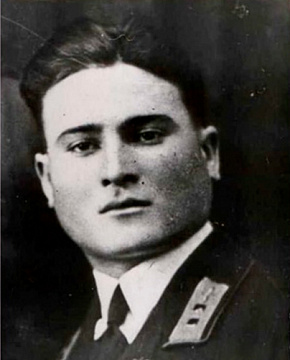Nikolai Liskonozhenko was born far from Malaya Vishera, but it is here that he died while defending our small town when it was attacked from the air. It was for his feats in and around Malaya Vishera that he received the Hero of the Soviet Union title.
Here is the profile from the Red Army documents on his service. Nikolai Liskonozhenko arrived from the Melitopol Aeroclub, enrolled at the Myasnikov Pilot Training Academy on January 1, 1938, and graduated from it as a sub-lieutenant. In this rank, he was sent to an Air Defence Unit as per the Order of the National Defence Committee No. 01454 dated 23 August 1938.
It was in the northern skies of Leningrad that the young pilot started his service after graduating from the Kachin Air Academy, and it is here that he had his maiden combat mission against Finland. Liskonozhenko demonstrated his piloting skills as he fought to defend Leningrad. He could fly in any weather and was very good at locating his targets. This was especially valuable on cloudy, frosty days, which was the case for most of the war against Finland. He flew on missions even when he could barely see anything around him.
Pilots from Liskonozhenko’s unit guarded Leningrad’s air space from the early days of the Great Patriotic War. Together with his fighter regiment, Liskonozhenko arrived at the Volkhovsky Front in October 1941, based in Verebye. The fact that Nikolai and his fellow servicemen had to fly three or four combat missions every day demonstrates just how tense the situation was in the beginning of the war. Quite often, Nikolai and his friends had to fly near Malaya Vishera, Chudovo, Budogoshchi and Kirishi.
On 2 November 1941, the fighter pilots from the 513th Fighter Regiment were sent on a combat mission to provide cover for the Soviet troops along a railway, and then to attack an enemy river crossing on the Volhov.
Lieutenant Liskonozhenko demonstrated exceptional courage and heroism during this engagement. Having received the order to provide cover from the air for the Soviet ground forces, a squadron piloted by Liskonozhenko, Zuyev and Klyuchko took off and reached the target area in a matter of 15 minutes. Nazi planes emerged on the horizon in just a few minutes: there were six Junkers Ju 88 bombers, covered by 6 Me-109 fighter planes. Loaded with bombs the Junkers planes roared heavily toward Selishchi, where the command post was located.
It was during this battle that a double aerial ramming was performed for the first time in the history of aviation. Nikolai Liskonozhenko was covered in blood, and his plane suffered serious damage, but he still managed to return to the Soviet territory and land. When his fellow soldiers reached the plane, the pilot was unconscious. They took him out carefully and transported him to the hospital of the 25th Cavalry Division, near Krasenka.
The doctors fought for his life, but failed. He succumbed to his wounds, sacrificing his life for carrying out a combat order. He disorganised the enemy planes, forcing them to drop the bombs before they reached their targets. Those of the pilots who returned from the mission shared another detail that no one noticed from the ground: during the first contact Liskonozhenko set a Nazi bomber on fire, which meant that he downed three enemy aircraft in a single battle.
Nikolai Liskonozhenko was buried in Kamenka, in Novgorod Region’s Malovishersky District, but his grave was later transferred to Malaya Vishera’s central cemetery. For his excellence in performing combat missions on the frontline against the Nazi invaders, and for his courage and heroism, Nikolai Liskonozhenko received the Hero of the Soviet Union title, as well as the Order of Lenin and the Golden Star medal, as per the Executive Order of the Presidium of the Supreme Council of the USSR dated 27 December 1941. In 1950, Nikolai Liskonozhenko’s mother, who lived in Melitopol, received a Hero’s Certificate in memory of the feat her son accomplished for the sake of his Motherland.
The hero’s name lives on. On 20 December 1958, the USSR Ministry of Defence issued the Order No. 243 to perpetually inscribe lieutenant Liskonozhenko into the 1st squadron of the 35th Berlin Bomber Aviation Regiment awarded the Suvorov and Bogdan Khmelnitsky Orders. The Novgorod land cherishes the memory of the fallen hero. A street in Malaya Vishera carries his name, and a monument has been erected on his tomb. A pioneer unit in the Gryadskaya secondary school No. 4 was also named after Liskonozhenko, and the school opened a museum in his memory. Today, it is the Malaya Vishera local history and lore museum that preserves these funds. In the 1950s, Komsomol members in Odessa organised a scrap metal drive to build a diesel locomotive, also called after Liskonozhenko, and the pilot’s mother attended the unveiling ceremony.

The Novgorod Region


Free with Russian
Nikolai Liskonozhenko
Red Army Lieutenant, Great Patriotic War veteran and Hero of the Soviet Union
